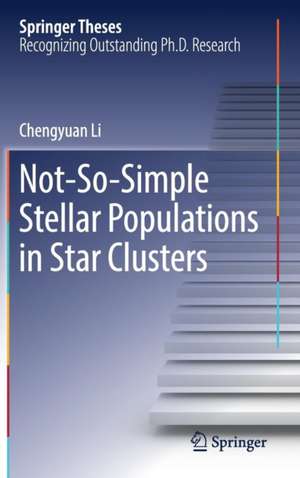Not-So-Simple Stellar Populations in Star Clusters: Springer Theses
Autor Chengyuan Lien Limba Engleză Hardback – 28 sep 2017
| Toate formatele și edițiile | Preț | Express |
|---|---|---|
| Paperback (1) | 633.19 lei 6-8 săpt. | |
| Springer Nature Singapore – 12 dec 2018 | 633.19 lei 6-8 săpt. | |
| Hardback (1) | 639.41 lei 6-8 săpt. | |
| Springer Nature Singapore – 28 sep 2017 | 639.41 lei 6-8 săpt. |
Din seria Springer Theses
- 18%
 Preț: 997.88 lei
Preț: 997.88 lei -
 Preț: 389.88 lei
Preț: 389.88 lei - 15%
 Preț: 646.94 lei
Preț: 646.94 lei - 18%
 Preț: 943.43 lei
Preț: 943.43 lei -
 Preț: 399.29 lei
Preț: 399.29 lei - 18%
 Preț: 944.99 lei
Preț: 944.99 lei - 15%
 Preț: 636.80 lei
Preț: 636.80 lei - 18%
 Preț: 941.05 lei
Preț: 941.05 lei - 15%
 Preț: 643.16 lei
Preț: 643.16 lei - 15%
 Preț: 642.68 lei
Preț: 642.68 lei - 18%
 Preț: 1103.62 lei
Preț: 1103.62 lei - 20%
 Preț: 558.82 lei
Preț: 558.82 lei - 18%
 Preț: 1112.30 lei
Preț: 1112.30 lei - 18%
 Preț: 944.19 lei
Preț: 944.19 lei - 18%
 Preț: 1109.92 lei
Preț: 1109.92 lei - 18%
 Preț: 1217.27 lei
Preț: 1217.27 lei - 15%
 Preț: 640.06 lei
Preț: 640.06 lei - 15%
 Preț: 636.45 lei
Preț: 636.45 lei - 15%
 Preț: 640.06 lei
Preț: 640.06 lei - 15%
 Preț: 640.88 lei
Preț: 640.88 lei -
 Preț: 389.70 lei
Preț: 389.70 lei - 20%
 Preț: 563.89 lei
Preț: 563.89 lei -
 Preț: 393.35 lei
Preț: 393.35 lei - 15%
 Preț: 637.93 lei
Preț: 637.93 lei - 15%
 Preț: 641.85 lei
Preț: 641.85 lei - 18%
 Preț: 1225.94 lei
Preț: 1225.94 lei - 20%
 Preț: 551.36 lei
Preț: 551.36 lei - 18%
 Preț: 1229.10 lei
Preț: 1229.10 lei - 15%
 Preț: 639.25 lei
Preț: 639.25 lei - 18%
 Preț: 999.45 lei
Preț: 999.45 lei - 15%
 Preț: 640.06 lei
Preț: 640.06 lei - 18%
 Preț: 1220.45 lei
Preț: 1220.45 lei - 18%
 Preț: 1116.26 lei
Preț: 1116.26 lei - 18%
 Preț: 1110.72 lei
Preț: 1110.72 lei - 18%
 Preț: 1000.87 lei
Preț: 1000.87 lei - 18%
 Preț: 891.17 lei
Preț: 891.17 lei - 15%
 Preț: 640.06 lei
Preț: 640.06 lei - 5%
 Preț: 1154.07 lei
Preț: 1154.07 lei - 15%
 Preț: 635.96 lei
Preț: 635.96 lei - 15%
 Preț: 640.88 lei
Preț: 640.88 lei -
 Preț: 387.20 lei
Preț: 387.20 lei - 18%
 Preț: 1109.92 lei
Preț: 1109.92 lei -
 Preț: 385.25 lei
Preț: 385.25 lei -
 Preț: 385.25 lei
Preț: 385.25 lei - 18%
 Preț: 1112.30 lei
Preț: 1112.30 lei - 18%
 Preț: 999.45 lei
Preț: 999.45 lei -
 Preț: 386.99 lei
Preț: 386.99 lei - 15%
 Preț: 637.13 lei
Preț: 637.13 lei - 20%
 Preț: 554.20 lei
Preț: 554.20 lei - 20%
 Preț: 555.57 lei
Preț: 555.57 lei
Preț: 639.41 lei
Preț vechi: 752.24 lei
-15% Nou
Puncte Express: 959
Preț estimativ în valută:
122.37€ • 126.41$ • 101.84£
122.37€ • 126.41$ • 101.84£
Carte tipărită la comandă
Livrare economică 25 martie-08 aprilie
Preluare comenzi: 021 569.72.76
Specificații
ISBN-13: 9789811056802
ISBN-10: 9811056803
Pagini: 320
Ilustrații: XV, 132 p. 56 illus., 44 illus. in color.
Dimensiuni: 155 x 235 mm
Greutate: 0.39 kg
Ediția:1st ed. 2017
Editura: Springer Nature Singapore
Colecția Springer
Seria Springer Theses
Locul publicării:Singapore, Singapore
ISBN-10: 9811056803
Pagini: 320
Ilustrații: XV, 132 p. 56 illus., 44 illus. in color.
Dimensiuni: 155 x 235 mm
Greutate: 0.39 kg
Ediția:1st ed. 2017
Editura: Springer Nature Singapore
Colecția Springer
Seria Springer Theses
Locul publicării:Singapore, Singapore
Cuprins
Star Formation, Evolution and Stellar Populations in Star Clusters Stellar Evolution and Populations.- Researches of Stellar Populations in Star Clusters.- Researches on Stellar Populations in Massive Star Clusters Binary Fraction in Young Massive Star Clusters.- The Formation and Evolution of Blue Straggler Stars in Globular Cluster.- Multiple Stellar Populations in the Giant Branches of Galactic Globular Clusters.- Do Intermediate-age Star Clusters have Extended Star Formation Histories?.- Not-so-simple Stellar Populations in Massive Star Clusters, Where Do We Stand? Lessons Learned from this Thesis.
Notă biografică
Chengyuan Li obtained his Ph.D degree in astronomy and astrophysics from the Department of Astronomy of Peking University in July 2015. His research focuses on stellar populations in star clusters, which involves the subjects of binaries, blue straggler stars and star formations in star clusters. He subsequently won a project research fellow in Purple Mountain Observatory of Chinese Academy of Sciences. In Oct. 2015, he won the Macquarie Research Fellowship at Macquarie University, Australia.
Textul de pe ultima copertă
This book focuses on understanding the stellar populations of massive star clusters, which aims to investigate the origin, evolution and properties of binary systems, their collision products, as well as the general characteristics (e.g. ages, metal content) of stellar population(s) in star clusters. It introduces the basic background knowledge of various stellar populations in star clusters as well as their formation, interaction and evolution, offering high impact observational results on our understanding of the formation and evolution mode of star clusters. Based on these discoveries, this book proposes a series of future projects that will shed light on these topics. The works that introduced in this book will have the unique potential to reveal the key features of star clusters formation and by extension how all stars formed in our universe.
Caracteristici
Nominated as an outstanding Ph.D. Thesis by Peking University Focuses on open questions of stellar populations in star clusters, providing a series of striking discoveries which offer deep insights into this topic Offers knowledge of stellar populations to help readers better understand the formation and evolution of star clusters and their member stars Proposes prospects and feasible projects of solving the problem of multiple stellar populations in star clusters Includes supplementary material: sn.pub/extras
